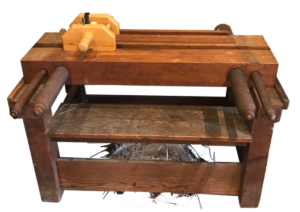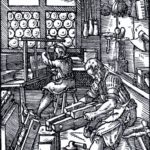Lying Press and Plough, American, 20th Century

20th century Press and Plow; design essentially unchanged since the 17th century.
Before mechanization the lying press was the binder’s all-purpose mainstay piece of equipment, used for backing books, pressing textblocks, gilding edges, and, with its accessory the plough, for trimming the edges of text blocks prior to shaping and covering. The design was developed in the fifteenth century, was refined in the eighteenth century, and has remained largely unchanged (and in use by many hand-binders) to the present day.

Jost Amman, The Bookbinder
Possibly the first image of a lying press in use comes from Jost Amman’s 1568 Book of Trades. In the foreground of a cluttered bookbinder’s shop we can see a binder with a lying press in his lap, using the plough (a plane-like contraption with a blade extending just far enough on the inner cheek to trim a page or two at a time when passed back and forth along the length of the press). Accessories such as cutting boards, backing boards, and gilding boards allowed the lying press to do the job of a gilding press or finishing press. While the form of the press was refined, its basic function—to hold pages under pressure—remained the same.
As with many of the tools of the hand bindery, in larger book manufactories the lying press was gradually replaced in the 19th century by a variety of specialized machines: board shears (to trim cover board), the guillotine (to trim entire text blocks at once), and roller backer (to back the text block prior to casing-in). Presses specially made for gilding, using iron rather than wooden screws, could hold multiple copies for preparation and application of gold leaf. (2) Still, for smaller edition binderies and design binders, the lying press remains a fundamental tool of the trade.
1)The lying press seen here is on loan from Mills College in Oakland, California. It was owned by Florence S. Walter (1884–1972), a notable Bay Area bookbinder. Examples of her work can be seen here.
2) Ellenport, Sam. Gilding at the Harcourt Bindery

